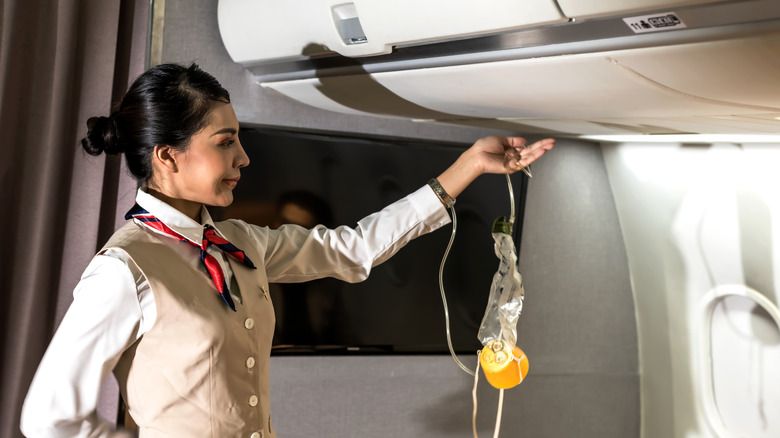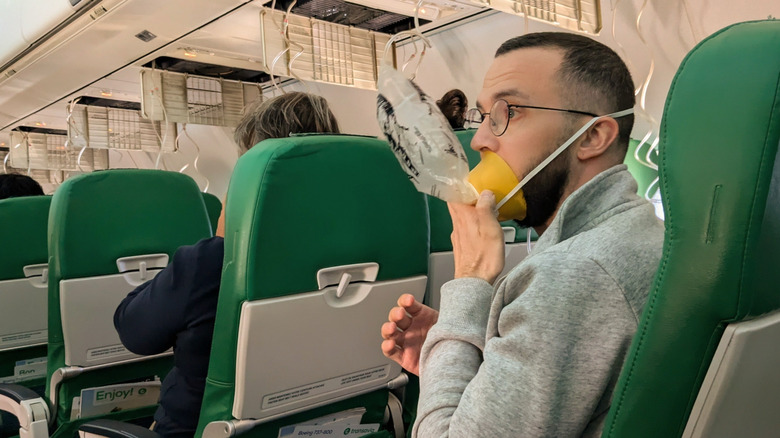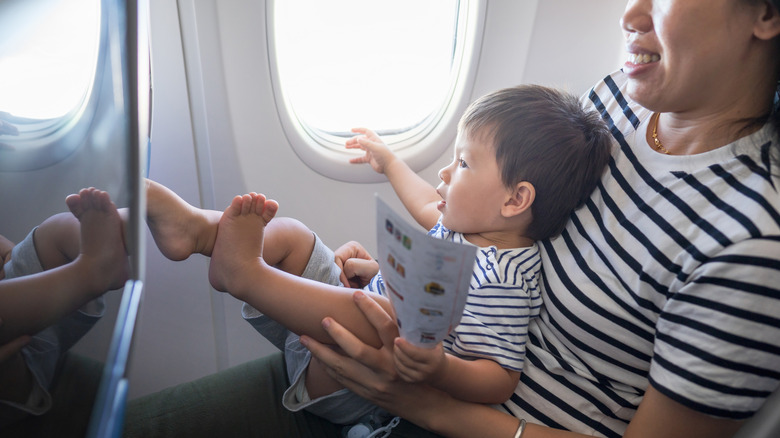The Eerie Fact About A Plane's Oxygen Masks That May Leave You Feeling A Bit Uneasy
You hear it at the beginning of every flight: In the event of an emergency, oxygen masks will drop from the plane ceiling for all passengers. But how much oxygen is really available for each flier? The answer might be less than you think. Believe it or not, each person only gets about 12 minutes of oxygen before the supply runs out. As unsettling as that information sounds, it might actually be more than you need in an emergency. To find out why, Islands spoke to Captain Richard Levy, who flew for American Airlines for more than four decades before retiring and serving as an aviation expert and instructor at another major U.S. airline.
Flying is an extremely safe kind of travel statistically, but scary cases like the series of Boeing 737 airplane accidents can still get us thinking about emergencies that happen in the air. If you've been worrying about how long airplane oxygen masks really last, you're in luck. Captain Levy assured us: "Is the supply of oxygen on commercial airliners sufficient? The simple answer is yes."
Why is there so little oxygen for passengers in emergencies?
When the oxygen masks on an airplane deploy automatically or the captain manually releases them, passengers are instructed to put them on immediately. If these devices are so vital, however, why do they only work for 12 minutes? Captain Richard Levy explained that masks are designed for one specific emergency: the sudden loss of cabin pressurization. This unlikely event might occur because of an issue with the pressurization system, human error, or a structural issue with the plane, like the time in 2024 when an airplane door flew off during a flight. No matter why it happened, however, Captain Levy told us that the pilot's response would be an unexpected emergency descent — and that happens fast.
As eerie as only having 12 minutes of air for emergencies might sound, it's actually more than twice as much as you would need to stay safe. Captain Levy explained, "An emergency descent from 35,000 feet, where air is too thin to breathe, to 14,000 feet where the air is breathable, or even better 10,000 feet where the air is even thicker, meaning more habitable for humans, takes four to five minutes."
Is there enough oxygen for everyone on board?
Luckily, if you're on a commercial flight operated by a major airline, you can rest assured that there are enough oxygen masks on board for everyone — and probably far more than are needed. Whether you're flying on an enormous Airbus A380-800 or a little Embraer 145, Captain Richard Levy assured us that there is a mask available for every passenger on the plane. He also told us that to comply with federal regulations, there is also one extra mask per row.
Typically, those extra masks are for babies and children small enough to ride on their parents' laps rather than having their own seats, which is why only one lap child is allowed per row. Levy explained that cabin crew might also use them, if they had to, stating, "If the flight attendant cannot get to their jumpseat during an emergency descent, or needs to assist a passenger having difficulty with their mask, the flight attendant will pull down the extra mask, activate the flow of oxygen, and then be able to survive the emergency descent." So, even if 12 minutes' worth of oxygen doesn't sound like much, know that the cabins are equipped with more than enough air for all passengers until the plane reaches safety.


